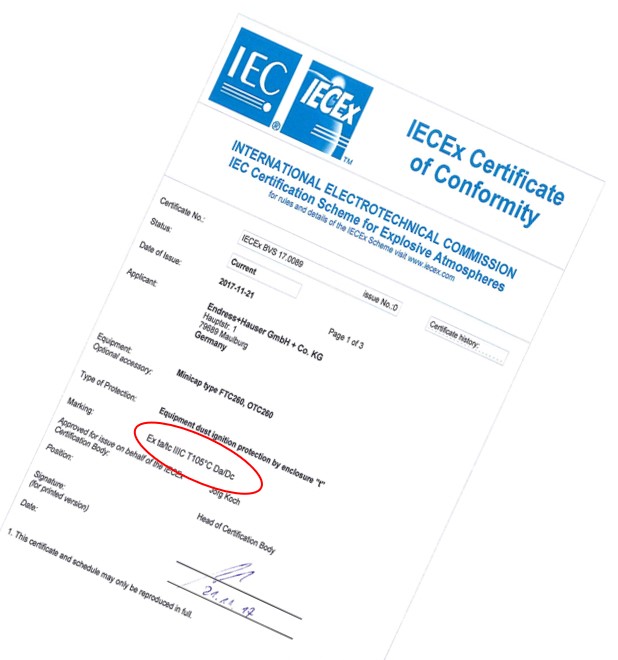How Roar Solutions can Save You Time, Stress, and Money.
How Roar Solutions can Save You Time, Stress, and Money.
Blog Article
The smart Trick of Roar Solutions That Nobody is Discussing
Table of ContentsSome Known Details About Roar Solutions Not known Details About Roar Solutions The Facts About Roar Solutions Revealed
In order to safeguard setups from a prospective surge a method of evaluating and identifying a possibly dangerous area is called for. The objective of this is to ensure the proper option and setup of tools to eventually protect against an explosion and to make certain security of life.
(https://papaly.com/categories/share?id=f67ddeb126ff42bfb724a48f0cebd961)
No devices needs to be set up where the surface area temperature level of the devices is higher than the ignition temperature of the provided danger. Below are some usual dirt harmful and their minimum ignition temperature. Coal Dust 380C 225C Polythene 420C (melts) Methyl Cellulose 420C 320C Starch 460C 435C Flour 490C 340C Sugar 490C 460C Grain Dust 510C 300C Phenolic Resin 530C > 450C Aluminium 590C > 450C PVC 700C > 450C Residue 810C 570C The chance of the risk existing in a concentration high sufficient to cause an ignition will certainly differ from place to location.
In order to identify this danger a setup is divided into locations of danger relying on the quantity of time the dangerous is present. These locations are referred to as Zones. For gases and vapours and dirts and fibers there are 3 areas. Area 0 Zone 20 A hazardous environment is very most likely to be existing and might exist for lengthy periods of time (> 1000 hours per year) or also continually Zone 1 Area 21 An unsafe atmosphere is feasible yet not likely to be existing for extended periods of time (> 10 450 C [842 F] A classification of T6 indicates the minimum ignition temperature level is > 85 C [185 F] Unsafe location electrical equipment perhaps designed for use in greater ambient temperature levels. This would showed on the score plate e.g. EExe II C T3 Ta + 60C( This indicates at 60C ambient T3 will certainly not be exceeded) T1 T1, T2, T3, T4, T5, T6 T2 T2, T3, T4, T5, T6 T3 T3, T4, T5, T6 T4 T4, T5, T6 T5 T5, T6 T6 T6 A T Course score of T1 indicates the maximum surface area temperature level generated by the instrument at 40 C is 450 C. Assuming the associated T Class and Temperature ranking for the equipment are appropriate for the location, you can always use a tool with a more rigorous Division rating than required for the area. There isn't a clear answer to this inquiry. It actually does depend upon the kind of equipment and what repair work require to be accomplished. Tools with particular examination treatments that can't be carried out in the area in order to achieve/maintain third celebration ranking. Need to return to the manufacturing facility if it is before the equipment's solution. Area Repair Work By Authorised Worker: Complex testing may not be required nevertheless details procedures might require to be adhered to in order for the equipment to keep its 3rd party score. Authorised personnel need to be utilized to carry out the work properly Repair service must be a like for like replacement. New component should be thought about as a straight substitute needing no special testing of the devices after the repair service is total. Each piece of tools with a harmful rating must be evaluated separately. These are detailed at a high degree listed below, however, for more in-depth info, please refer straight to the guidelines.
Roar Solutions for Dummies
The equipment register is an extensive database of devices records that consists of a minimum collection of areas to recognize each item's area, technical parameters, Ex-spouse classification, age, and ecological information. This info is vital for tracking and managing the tools efficiently within hazardous areas. In comparison, for periodic or RBI tasting evaluations, the quality will be a combination of Detailed and Close assessments. The proportion of Comprehensive to Shut inspections will be established by the Equipment Danger, which is analyzed based on ignition danger (the chance of a source of ignition versus the likelihood of a combustible atmosphere )and the dangerous location category
( Zone 0, 1, or 2). This variant will certainly additionally influence the resourcing demands for work prep work. As soon as Lots are defined, you can establish sampling strategies based on the example dimension of each Whole lot, which describes the variety of arbitrary tools items to be examined. To establish the required sample size, two aspects need to be assessed: the size of the Great deal and the classification of examination, which shows the degree of initiative that should be applied( decreased, typical, or enhanced )to the assessment of the Great deal. By integrating the classification of assessment with the Whole lot dimension, you can then establish the suitable being rejected criteria for a sample, meaning the allowed variety of defective products found within that example. For more details on this process, please refer to the Energy Institute Guidelines. The IEC 60079 conventional suggests that the optimum interval in between evaluations ought to not surpass 3 years. EEHA inspections will likewise be conducted beyond RBI projects as part of set up upkeep and devices overhauls or repairs. These examinations can be attributed towards the RBI sample sizes within the impacted Lots. EEHA evaluations are carried out to identify mistakes in electric equipment. A heavy racking up system is vital, as a single item of devices might have several faults, each with varying degrees of ignition danger. If the mixed rating of both evaluations is less than twice the fault rating, the Great deal is considered acceptable. If the Lot is still taken into consideration undesirable, it needs to undergo a complete evaluation or validation, which may cause stricter assessment protocols. Accepted Whole lot: The reasons for any type of faults are determined. If an usual failure helpful resources setting is located, extra devices might require assessment and repair. Mistakes are identified by extent( Safety and security, Integrity, House cleaning ), ensuring that urgent concerns are assessed and attended to immediately to mitigate any effect on safety and security or operations. The EEHA data source ought to track and tape the lifecycle of mistakes together with the corrective activities taken. Implementing a robust Risk-Based Examination( RBI )strategy is vital for ensuring compliance and security in taking care of Electrical Devices in Hazardous Areas( EEHA) (eeha certificate). Automated Mistake Scoring and Lifecycle Administration: Effortlessly take care of mistakes and track their lifecycle to enhance evaluation precision. The intro of this assistance for risk-based inspection additionally strengthens Inspectivity's setting as a best-in-class option for regulatory conformity, as well as for any asset-centric assessment usage case. If you want finding out more, we welcome you to ask for a demonstration and find how our remedy can transform your EEHA monitoring procedures.
Getting My Roar Solutions To Work

In regards to explosive danger, an unsafe location is a setting in which an explosive atmosphere exists (or may be anticipated to be existing) in amounts that call for special precautions for the building and construction, installation and usage of tools. high voltage courses. In this article we check out the difficulties encountered in the workplace, the threat control steps, and the required competencies to work securely
It issues of modern life that we produce, keep or handle a range of gases or fluids that are regarded flammable, and a variety of dirts that are regarded flammable. These compounds can, in specific conditions, develop explosive ambiences and these can have significant and awful repercussions. Many of us recognize with the fire triangle remove any kind of one of the 3 components and the fire can not occur, but what does this mean in the context of unsafe areas? When damaging this down right into its simplest terms it is basically: a combination of a specific quantity of launch or leak of a particular material or material, blending with ambient oxygen, and the presence of a resource of ignition.
In most instances, we can do little about the degrees of oxygen airborne, but we can have significant influence on resources of ignition, for instance electric equipment. Unsafe locations are recorded on the unsafe location category illustration and are recognized on-site by the triangular "EX-SPOUSE" indicator. Below, among other crucial info, zones are divided into three types depending upon the hazard, the chance and period that an eruptive ambience will exist; Area 0 or 20 is considered one of the most harmful and Area 2 or 22 is regarded the least.
Report this page